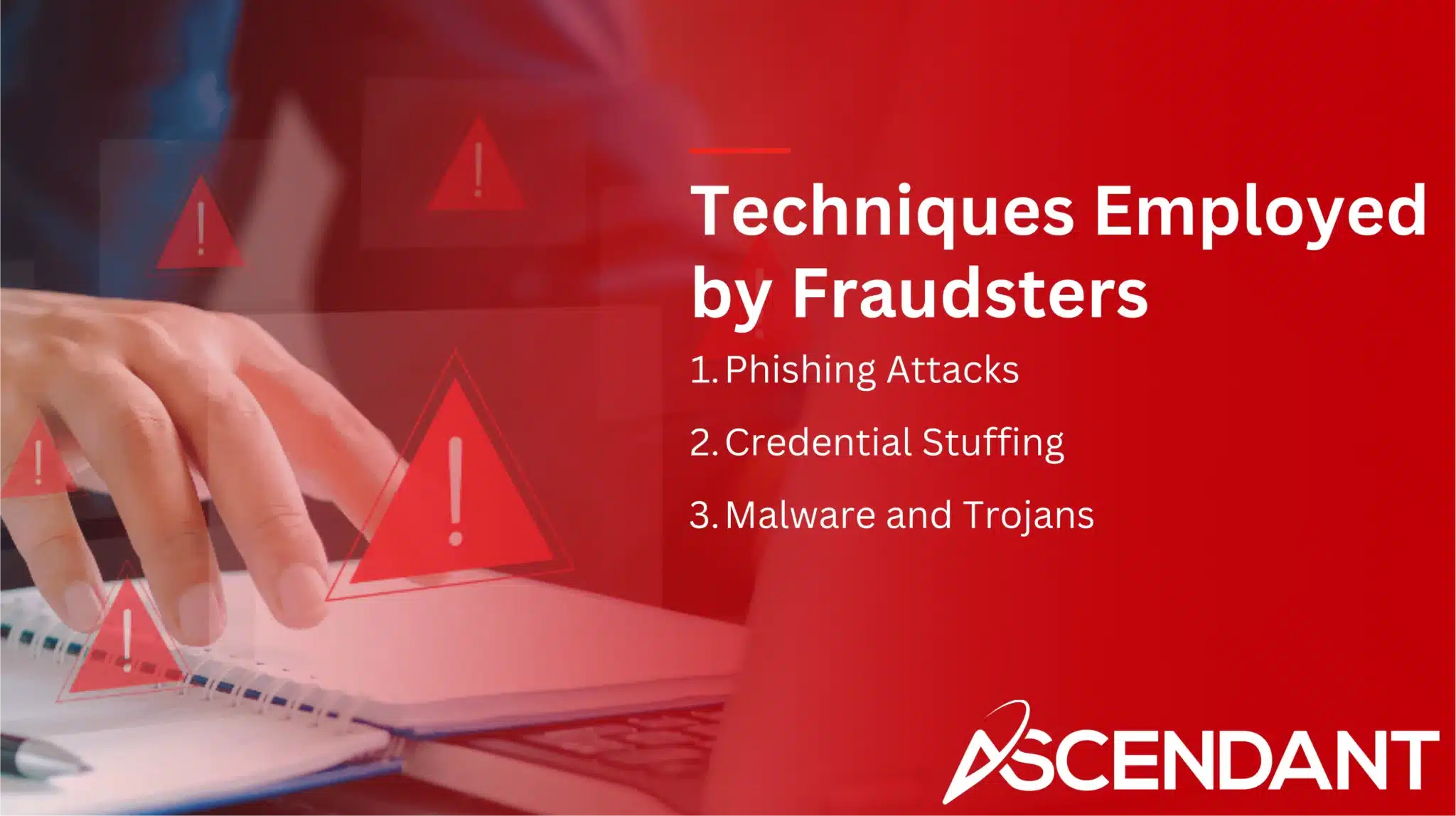Account takeover fraud involves cybercriminals accessing user accounts without permission using stolen credentials. This guide explains what account takeover fraud is, how it happens, and how you can prevent it.
In This Article:
- Understanding Account Takeover Fraud
- Techniques Employed by Fraudsters
- Detecting Account Takeover Fraud
- Preventing Account Takeover Fraud
- The Role of Financial Institutions in Combatting ATO
- Impact of Account Takeover Fraud
- Advanced Technologies in ATO Prevention
Key Takeaways
- Account takeover fraud (ATO) is a severe cybercrime that exploits stolen credentials, leading to substantial financial and reputational harm for individuals and businesses.
- Key prevention strategies against ATO include user education on phishing and password hygiene, implementation of multi-factor authentication, and deployment of real-time fraud detection systems.
- Continuous monitoring of user behavior, anomaly detection, and the use of advanced technologies like AI are crucial for effectively identifying and mitigating the impacts of account takeover fraud.
Understanding Account Takeover Fraud
Account takeover ATO fraud constitutes a pernicious type of cybercrime, wherein wrongdoers unlawfully access user accounts through the use of purloined login information. This nefarious conduct can result in substantial financial loss and tarnish reputations, impacting both individuals and corporations. As dependence on online transactions for financial accounts intensifies, it concurrently broadens the potential for exploitation by these criminals—amplifying our susceptibility to account takeovers and associated fraudulent activities.
The ripple effects of compromised accounts extend widely. Swindlers often utilize these hijacked identities to make unauthorized purchases or withdrawals, abscond with sensitive data, and perpetrate identity theft. Grasping the essence as well as strategies behind ato fraud equips us more robustly to thwart this widespread peril.
Definition of Account Takeover Fraud
Cybercriminals commit account takeover fraud by obtaining unauthorized entry to user accounts with the use of stolen credentials. They may achieve this through techniques like session hijacking, in which attackers take control of a user’s session and authentication token, or they might exploit users’ habits of reusing passwords for multiple accounts.
The darknet serves as an influential platform where attackers can buy legitimate user accounts rather than trying to decrypt passwords themselves.
Common Methods Used in ATO
Scammers utilize a variety of strategies to carry out account takeover attacks. A widespread approach is phishing, where they use misleading emails or websites to fool individuals into divulging their private data.
Credential stuffing stands as another frequent tactic used by attackers, taking advantage of users’ habit of repeating the same passwords on various sites. This enables culprits to infiltrate numerous accounts using identical login details. Awareness of these tactics is crucial in the fight against preventing account takeover fraud and securing one’s account credentials.
Techniques Employed by Fraudsters
Cybercriminals are continuously refining their strategies to circumvent security protocols, utilizing a plethora of methods for committing account takeover fraud (ATO). Tools such as SentryMBA, SNIPR, STORM, and MailRanger enhance the efficiency of these breaches. This escalation in bot activity and progressive assault techniques poses a significant challenge for teams dedicated to fraud detection. Strengthening our identification capabilities against ATO is critical.
Indicators that an account may be under siege by ATO include repeated requests to change passwords coupled with a high volume of failed login attempts which suggest unauthorized individuals trying to gain access. Any deviation from established spending patterns or shopping behaviors could signal that an intruder has breached an account’s security.
To counteract the onslaught of automated login efforts intrinsic to ATO schemes, it’s imperative for organizations to enforce restrictions on the frequency at which failed login attempts can occur tied to specific usernames, devices, or IP addresses.
Phishing Attacks
Phishing attacks are a common precursor to account takeover fraud. These scams impersonate trusted brands to trick users into revealing their credentials through fake portals or malicious links. Phishing attempts can be initiated via emails, SMS links, and social media messaging, redirecting users to fake sites or installing malware.
Fraudsters make these attempts more convincing by including personal details collected from social media, thereby increasing their chances of success.
Credential Stuffing
The practice of credential stuffing employs bots to automate and scale the testing of compromised credentials across various websites, taking advantage of users’ habit of reusing their passwords. This automation enhances the criminals’ ability to carry out large-scale attacks more effectively, rendering credential stuffing a notable security concern.
Implementing multi-factor authentication introduces an additional barrier that can thwart attempts at credential stuffing by adding an extra layer to safeguard against unauthorized access.
Malware and Trojans
Fraudsters utilize malware and trojans as powerful weapons. Through overlay attacks, mobile banking Trojans trick users by capturing their authentication details when they input them into fraudulent interfaces designed to look legitimate. Keyloggers represent a different type of malware that records all keystrokes made by the user, thereby obtaining critical financial information.
Such nefarious software has the capability to alter transaction information in real-time while a banking operation is being conducted, facilitating fraudulent activities.
Detecting Account Takeover Fraud
Preventing account takeover fraud (ATO) is crucial in averting considerable financial and reputational harm. It’s vital to persistently scrutinize activities within accounts to catch early indicators of ATO. Despite this, the complexity arises as fraudsters skillfully replicate typical login behaviors, complicating the detection process. Implementing a comprehensive strategy that includes monitoring user actions, examining communication patterns, and integrating advanced technological methods is required.
To detect such fraudulent activities effectively involves conducting risk-based assessments which take into account factors like the user’s geographic location and their device’s unique characteristics to pinpoint irregularities in login behaviors. Employing bot detection systems equipped with machine learning algorithms along with modeling users’ behavior patterns can enhance our ability to spot suspect logins—establishing a formidable line of defense against ATO schemes.
Monitoring User Behavior
Regular monitoring of activities within an online account is essential to spotting abnormal behavior that could signal impending account takeover incidents. Frequent examination by users when they log in and access their accounts allows for the early recognition of potentially suspicious activity through transaction history scrutiny.
The implementation of transaction monitoring systems plays a crucial role, as these systems are adept at identifying irregularities instantly, thereby alerting financial institutions about unusual actions. Tools such as IP geolocation and anomaly detection work concurrently to scrutinize the geographic origins and behavioral trends associated with login attempts, aiming to highlight any activities that appear out of the ordinary.
Identifying Suspicious Activity
Monitoring for unusual behavior is crucial in safeguarding user accounts against account takeover fraud. Indications of a potential account takeover include several login attempts originating from disparate geographic regions. Repeated adjustments to account configurations, like password alterations, may suggest imminent threats of account takeovers.
Implementing notifications for instances when a user signs in or modifies their login credentials serves as an effective strategy to spot unauthorized access swiftly and helps mitigate risks associated with such intrusions promptly.
Preventing Account Takeover Fraud
To thwart account takeover fraud (ATO), it’s crucial to employ a multifaceted strategy that incorporates both educational initiatives for users and advanced security technology. By informing customers about typical scams, particularly how to identify phishing attempts and the importance of robust password management, their susceptibility to ATO can be markedly diminished.
It is imperative for financial institutions to implement holistic strategies dedicated to protecting user accounts against the risk of unauthorized takeovers. This involves perpetually updating and improving their defensive measures in order to effectively address ATO challenges.
An amalgamated approach that merges instructional efforts with cutting-edge technological solutions and stringent organizational protocols serves as an essential framework for preventing account takeover fraud.
Strong Password Policies
Maintaining good password hygiene is essential to prevent account takeover fraud. It’s important for users to establish strong passwords by generating lengthy combinations, incorporating a mix of character types, using both uppercase and lowercase letters, frequently updating their passwords, and steering clear of recycling old ones.
Reinforcing customer awareness about the significance of secure password creation underlines the critical nature of robust password practices in safeguarding against fraudulent takeovers. Advocating for discretion in not divulging confidential details plays a significant role in these best practices. The use of password managers can assist individuals in devising and managing sturdy, distinct passwords efficiently.
Multi-Factor Authentication (MFA)
Multi-factor authentication (MFA) necessitates that individuals present several verification types before they can obtain entry to their accounts. By demanding an item possessed by the user, such as a mobile device, alongside a password, MFA substantially diminishes the likelihood of illicit access.
Adding this protective tier intensifies the difficulty for non-authorized persons trying to gain access.
Real-Time Fraud Detection Systems
Proactive identification and the prevention of account takeover fraud are significantly enhanced by real-time fraud detection systems. These continuously operating systems employ adaptive algorithms that evolve to boost the success rate in spotting attempts at account takeovers.
Employing behavioral analytics, these systems detect unusual patterns in user behavior, offering an extra layer of defense against Account Takeover (ATO) incidents.
The Role of Financial Institutions in Combatting ATO
Financial entities fight against account takeover fraud (ATO) through stringent security protocols and educating their clients regarding looming dangers. The repercussions of ATO for businesses can be substantial, including serious financial loss and damage to reputation, which underscores the necessity for preventive actions. Trust from customers and business income can decline as a result of account takeovers.
In devising an effective system that thwarts all variants of account takeover tactics, these institutions encounter obstacles. By adopting exhaustive measures such as restrictions on login attempts and monitoring devices coupled with cutting-edge tech solutions, they are markedly improving their capability to counteract ATO effectively.
Continuous Monitoring and Alerts
Systems for monitoring in real-time are crucial as they identify and alert customers to any abnormal actions within their accounts instantly. These systems facilitate the recognition of atypical login behaviors, thereby thwarting unauthorized access attempts. The implementation of automated notification mechanisms when unusual activities occur is essential for the early identification of such unauthorized access.

Acting swiftly on incidents involving account takeovers following alerts sent to impacted individuals can significantly reduce financial damages. By consistently observing user behavior, these continuous surveillance measures pinpoint potential instances of account takeover as they unfold, enabling immediate intervention.
Educating Customers
By instructing customers in robust security measures, they become equipped to identify and sidestep imminent dangers, aiding the prevention of account takeover fraud. The advocacy for potent passwords bolsters the defenses of accounts, thereby reducing the chances of illicit entry.
The integration of multi-factor authentication alongside instantaneous fraud detection mechanisms strengthens protection through necessitating Credentials and vigilantly tracking irregular behavior.
Impact of Account Takeover Fraud
Account takeover fraud (ATO) entails the illegitimate use of an individual’s login information to gain access to their private accounts, potentially causing significant financial harm and damaging reputations. Both businesses and consumers face potential hazards from ATO, which can lead not only to monetary theft but also contribute significantly to data breaches. The Federal Trade Commission has identified a staggering $10 billion in fraudulent losses for 2023, with a large portion stemming from internet-based activities.
On average, victims suffer around $12,000 in financial loss per account takeover event. When accounts are compromised through such incidents, they can pave the way for identity theft that affects individuals by inflicting detrimental effects on their finances and negatively impacting credit scores. Given the extensive adverse impacts of ATO incidents, it is crucial for preventive strategies and strong protective measures against such attacks be put into place.
Financial Losses
Compromised accounts are a substantial factor in the financial losses experienced by victims due to unauthorized purchases. Fraudulent transactions and illicit shopping sprees frequently result from account takeovers, with fraudsters exploiting these breaches to gather sensitive personal data that can intensify the risks associated with identity theft.
The repercussions of identity theft stemming from account takeovers can be severe, leading not only to significant financial strain but also potentially damaging the credit scores of affected individuals.
Identity Theft
The theft of one’s identity can have a devastating effect on their credit score and overall fiscal well-being. Fraudsters gaining access to sensitive data through accounts that have been breached may result in identity theft.
It is imperative to implement top-tier methods for securing personal details as a safeguard against the threat of having one’s identity stolen.
Advanced Technologies in ATO Prevention
In the battle to combat account takeover fraud (ATO), cutting-edge technologies have proven to be essential. Utilizing machine learning and artificial intelligence, these advanced systems surpass conventional approaches in effectively detecting and curtailing potential risks. Financial entities are progressively incorporating such tools for continuous monitoring of accounts, enabling them to pinpoint imminent ATO dangers instantaneously.
These evolving technologies augment the capability of financial institutions in spotting fraudulent activities by examining patterns and user behaviors. They continually adjust their algorithms to counter novel threats, thereby reinforcing defenses against ATO incidents while concurrently bolstering customer confidence in security measures.
AI-Based Detection Technology
AI-based detection technology employs machine learning to scrutinize behaviors and patterns, enabling the precise recognition of fraudulent activities. By monitoring transactions as they happen, these continuous fraud detection systems employ real-time analysis to bolster security protocols significantly. The application of AI and machine learning advancements increases the precision in identifying potential fraud.
By adopting this cutting-edge AI technology, organizations can thwart account takeovers effectively, thus reinforcing customer confidence and fortifying security measures across their platforms.
Bot Detection and Mitigation
Solutions for detecting bots are crucial in pinpointing harmful actions, including the creation of fake accounts, scraping activities, and formjacking incidents. They provide warnings regarding attacks that occur on the client side such as digital skimming and formjacking by distinguishing between genuine human interactions and automated traffic to minimize instances of false positives.
Through the implementation of machine learning algorithms, these detection systems constantly evolve to recognize novel patterns of bot activity more effectively with time passing. The utilization of specialized tools for managing bots plays a pivotal role in safeguarding against automated threats which can lead to a substantial decrease in financial losses if left unaddressed.
Summary
Financial institutions are at the forefront of combating account takeover fraud (ATO), a type of threat that is on the rise and requires comprehensive strategies to effectively counteract it. It’s essential for these institutions to comprehend the methods used by criminals, identify any early signs of illicit behavior, and establish strong prevention protocols in order to shield user accounts from unauthorized access. In this ongoing battle against ATO, financial organizations must constantly be on guard for potential dangers while also providing guidance to their clients about how they can stay secure. The field of fraud detection has been revolutionized by cutting-edge innovations such as artificial intelligence (AI) and machine learning, which provide powerful resources in preventing instances of account takeover. Maintaining vigilance and adhering to best practices will enable us all to defend against the increasingly prevalent issue of account takeover fraud.
 Frequently Asked Questions
Frequently Asked Questions
What is account takeover fraud?
Account takeover fraud is a serious issue where cybercriminals gain unauthorized access to user accounts by exploiting stolen credentials, resulting in significant financial and reputational harm.
It is essential to take proactive measures to protect your accounts from such threats.
How can I protect myself from phishing attacks?
To effectively protect yourself from phishing attacks, exercise caution with unsolicited communications and verify the authenticity of links before clicking.
It is essential to refrain from sharing personal information through unverified channels.
What is credential stuffing and how can it be prevented?
Credential stuffing is the use of automated bots to exploit stolen credentials across various websites.
It can be prevented by employing unique passwords for different accounts and activating multi-factor authentication.
How does multi-factor authentication help in preventing ATO?
By necessitating multiple verification factors beyond a simple password, multi-factor authentication (MFA) serves as an effective barrier against account takeover (ATO), substantially mitigating the threat of illicit entry.
The adoption of MFA is a pivotal measure in fortifying security measures.
What should I do if I suspect my account has been compromised?
Should you have concerns that your account’s security has been breached, it is essential to swiftly modify your passwords, activate multi-factor authentication, and vigilantly track your accounts for any unusual activity.
It is crucial to alert your financial institution so they can apply additional safeguards.


